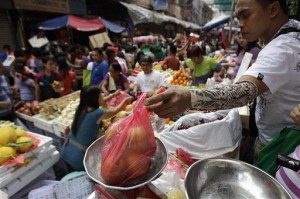Buy local fruits for New Year feast—DA

A Filipino vendor measures the weight of a fruit as people make their last-minute shopping along the busy shopping area of Divisoria in Manila on Christmas eve, Dec. 24, 2012. Ahead of the shopping rush for round fruits traditionally served in New Year feasts, the Department of Agriculture urged consumers to buy locally available fruits to support farmers and the country’s food sufficiency program. AP PHOTO/AARON FAVILA
MANILA, Philippines—Ahead of the shopping rush for round fruits traditionally served in New Year feasts, the Department of Agriculture urged consumers to buy locally available fruits to support farmers and the country’s food sufficiency program.
There are locally grown grapes from Bulacan, Rizal, Cavite and other provinces, as well as citrus fruits from Central Luzon and Bukidnon, according to Agriculture Secretary Proceso J. Alcala.
However, families may also consider other fruits such as suha (pomelo), guava, atis (custard apple), duhat (black plum), rambutan, santol, melon, calamansi (Philippine lemon), dalandan (Philippine orange), lanzones, chico, avocado, chesa, aratiles (local cherry), mangosteen, pakwan (watermelon), bignay (currant), mabolo, papaya, coconut (buko), granada (pomegranate), lipote/igot/bahag (round black plum), calumpit (small and round black plum), sampinit (Philippine strawberry) and yambo (rose apple).
Non-traditional homemakers might serve round varieties of langka (jackfruit), pineapple, mango, macopa, durian, balimbing (star fruit) and dragonfruit, Alcala said.
“Buying imported fruits is OK. But isn’t it better to celebrate and also support local farmers at the same time?” Alcala said in an interview. Aside from improving incomes of farmers focused on fruit production, buying local fruits would help those who have been growing fruits to supplement their income from other crops or other forms of farming such as livestock and fish farming, the agriculture secretary said. This would help sustain the country’s program to boost overall food production, Alcala said.
Article continues after this advertisementThe Philippines aims to achieve food staples sufficiency after 2013. The country is currently 97 to 98 percent self-sufficient in palay. As for corn, production currently matches the requirements of the livestock sector, according to the agriculture department. “High-value crops are also getting more attention, including organic growing of vegetables and fruits,” Alcala said.
Article continues after this advertisementAlcala assured the public of enough food supply despite recent typhoons. He projected that the country’s agriculture and fishery sector would register positive growth.
Tropical storm Quinta caused relatively “minimal” damage to agriculture but benefited some areas where growing crops needed rainwater, Alcala said earlier. Agriculture damage due to tropical storm Quinta has reached P124.4 million, according to data from the Department of Agriculture.
Alcala said such damage was comparatively small and yet rains from the tropical storm saved some areas from drought.” There were in fact some areas where the DA had contracted cloud seeding to induce rains for flowering crops but no longer needed such services due to rains from ‘Quinta,'” Alcala said.
Farm output grew 1.93 percent, a slower pace from 4.74 percent in the same period last year, even as fish production continued to slow down. For the whole year of 2011, farm output grew 2.34 percent, or lower than the revised three to 3.5 percent projected by the Bureau of Agricultural Statistics.